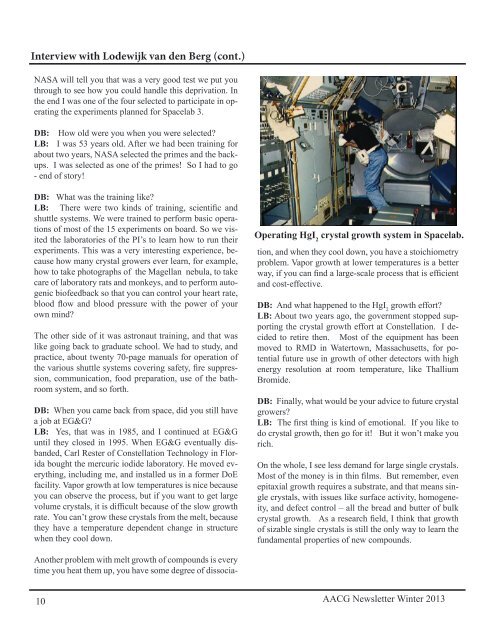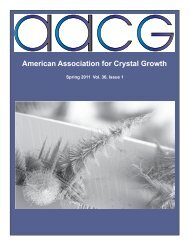President's Corner (cont.) - American Association for Crystal Growth
President's Corner (cont.) - American Association for Crystal Growth
President's Corner (cont.) - American Association for Crystal Growth
Create successful ePaper yourself
Turn your PDF publications into a flip-book with our unique Google optimized e-Paper software.
Interview with Lodewijk van den Berg (<strong>cont</strong>.)<br />
NASA will tell you that was a very good test we put you<br />
through to see how you could handle this deprivation. In<br />
the end I was one of the four selected to participate in operating<br />
the experiments planned <strong>for</strong> Spacelab 3.<br />
DB: How old were you when you were selected?<br />
LB: I was 53 years old. After we had been training <strong>for</strong><br />
about two years, NASA selected the primes and the backups.<br />
I was selected as one of the primes! So I had to go<br />
- end of story!<br />
DB: What was the training like?<br />
LB: There were two kinds of training, scientific and<br />
shuttle systems. We were trained to per<strong>for</strong>m basic operations<br />
of most of the 15 experiments on board. So we visited<br />
the laboratories of the PI’s to learn how to run their<br />
experiments. This was a very interesting experience, because<br />
how many crystal growers ever learn, <strong>for</strong> example,<br />
how to take photographs of the Magellan nebula, to take<br />
care of laboratory rats and monkeys, and to per<strong>for</strong>m autogenic<br />
biofeedback so that you can <strong>cont</strong>rol your heart rate,<br />
blood flow and blood pressure with the power of your<br />
own mind?<br />
The other side of it was astronaut training, and that was<br />
like going back to graduate school. We had to study, and<br />
practice, about twenty 70-page manuals <strong>for</strong> operation of<br />
the various shuttle systems covering safety, fire suppression,<br />
communication, food preparation, use of the bathroom<br />
system, and so <strong>for</strong>th.<br />
DB: When you came back from space, did you still have<br />
a job at EG&G?<br />
LB: Yes, that was in 1985, and I <strong>cont</strong>inued at EG&G<br />
until they closed in 1995. When EG&G eventually disbanded,<br />
Carl Rester of Constellation Technology in Florida<br />
bought the mercuric iodide laboratory. He moved everything,<br />
including me, and installed us in a <strong>for</strong>mer DoE<br />
facility. Vapor growth at low temperatures is nice because<br />
you can observe the process, but if you want to get large<br />
volume crystals, it is difficult because of the slow growth<br />
rate. You can’t grow these crystals from the melt, because<br />
they have a temperature dependent change in structure<br />
when they cool down.<br />
Another problem with melt growth of compounds is every<br />
time you heat them up, you have some degree of dissocia-<br />
10<br />
Operating HgI 2 crystal growth system in Spacelab.<br />
tion, and when they cool down, you have a stoichiometry<br />
problem. Vapor growth at lower temperatures is a better<br />
way, if you can find a large-scale process that is efficient<br />
and cost-effective.<br />
DB: And what happened to the HgI 2 growth ef<strong>for</strong>t?<br />
LB: About two years ago, the government stopped supporting<br />
the crystal growth ef<strong>for</strong>t at Constellation. I decided<br />
to retire then. Most of the equipment has been<br />
moved to RMD in Watertown, Massachusetts, <strong>for</strong> potential<br />
future use in growth of other detectors with high<br />
energy resolution at room temperature, like Thallium<br />
Bromide.<br />
DB: Finally, what would be your advice to future crystal<br />
growers?<br />
LB: The first thing is kind of emotional. If you like to<br />
do crystal growth, then go <strong>for</strong> it! But it won’t make you<br />
rich.<br />
On the whole, I see less demand <strong>for</strong> large single crystals.<br />
Most of the money is in thin films. But remember, even<br />
epitaxial growth requires a substrate, and that means single<br />
crystals, with issues like surface activity, homogeneity,<br />
and defect <strong>cont</strong>rol – all the bread and butter of bulk<br />
crystal growth. As a research field, I think that growth<br />
of sizable single crystals is still the only way to learn the<br />
fundamental properties of new compounds.<br />
AACG Newsletter Winter 2013




